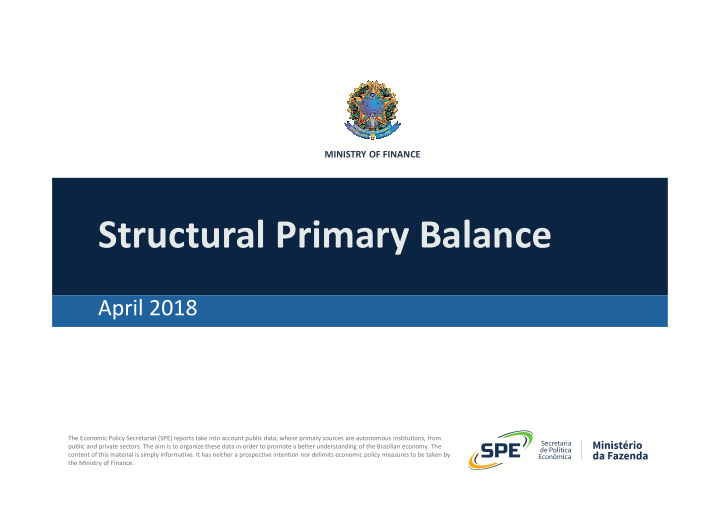



MINISTRY OF FINANCE Structural Primary Balance April 2018 The Economic Policy Secretariat (SPE) reports take into account public data, whose primary sources are autonomous institutions, from public and private sectors. The aim is to organize these data in order to promote a better understanding of the Brazilian economy. The content of this material is simply informative. It has neither a prospective intention nor delimits economic policy measures to be taken by the Ministry of Finance.
Concept • The Structural Primary Balance is the one consistent with trend GDP and Cyclical excludes: Component – The cyclical effects (GDP and Commodities); – Non-recurrent fiscal operations. Non- • For example, we cannot say that, recurrent structurally, the fiscal position: operations Fiscal – Worsens when the revenue falls due to a Balance recession; – Improves when there is an one-off revenue. Structural • Therefore, it guarantees a good Balance perception about how much expansionary or contractionary is the discretionary action of the fiscal policy. Source: SPE 2
Methodology • International methodologies are adapted to the Brazilian case, in four steps: – Adjusting important groups of Tax Revenues (including State Tax on Goods and Services and Municipal Tax on Services) to the GDP cycle. – Adjusting the royalties revenues and special oil participation to the oil price cycle. – Identifying the main non-recurrent operations that affected the fiscal balance. – Decomposing the cyclical component of the federal revenues transferred to the States and Municipalities. 3
GDP Cycles and Trend Projections 180 Output Gap Trend GDP 4% Fixed base Index - 1995 average =100 170 GDP Output Gap (% of Potential GDP) 160 2% 150 140 0% 130 -2% 120 110 -4% 100 90 -6% Source: SPE 4
Cyclical Component of the Public Sector Primary Balance (% GDP) 1.3% 1.1% 0.9% 0.5% 0.4% 0.2% 0.1% 0.1% 0.0% 0.0% -0.1% -0.3% -0.6% -1.1% -1.5% -1.6% Source: SPE 5
Non-Recurrent Fiscal Operations (% GDP) 1.1% 1.0% 1.0% 0.9% 0.9% 0.7% 0.7% 0.6% 0.5% 0.0% 0.0% 0.0% 0.0% 0.1% -0.2% -0.5% Source: SPE 6
Public Sector Conventional and Structural Primary Balances (% GDP) 3.8% 3.7% 3.7% 3.4% 3.2% 3.3% 3.2% 3.6% 3.8% 2.9% 2.6% 3.2% 2.6% 3.2% 2.9% 2.2% 2.6% 2.4% 1.7% 1.9% 1.9% 1.6% 1.1% -0.6% -0.3% -1.4% -1.5% -2.1% -1.7% Structural Conventional -1.9% -2.5% -2.6% Source: SPE 7
Structural Balance by Government Level (% PIB) 4.0% 3.8% 3.6% 3.8% 3.4% 3.5% 2.9% 3.0% 2.6% 2.6% 2.4% 2.5% 1.9% 2.0% 1.6% 1.5% 1.1% 1.0% 0.5% 0.0% -0.5% -0.3% -1.0% -1.5% -1.5% -1.4% -2.0% -2.5% -2.1% -2.6% -3.0% Central Government States and Municipalities State-Owned Enterprises Public Sector Source: SPE 8
Public Sector Fiscal Impulse (p.p.) The fiscal impulse evaluates the impact of the fiscal policy by calculating the difference of the fiscal balance of two consecutive years: a fiscal balance decrease means a expansionary impulse (+) while a fiscal balance increase indicates a contractionary impulse (-). 2.3 2.3 Conventional Structural 1.5 1.4 1.3 1.0 0.8 0.8 0.8 0.6 0.6 0.5 0.5 0.4 0.3 0.3 0.0 -0.1 -0.1 -0.1 -0.1 -0.2 -0.3 -0.3 -0.3 -0.5 -0.6 -0.7 -0.7 -0.8 -1.2 -1.4 Source: SPE 9
Fiscal Impulse by Government Level (% GDP) 2.5 2.3 2.0 1.5 1.5 1.0 0.8 1.0 0.8 0.5 0.4 0.3 0.5 0.3 -0.1 0.0 -0.3 -0.2 -0.3 -0.5 -0.6 -1.0 -1.4 -1.2 -1.5 Central Government States and Municipalities State-owned Companies Public Sector -2.0 Source: SPE 10
2017 Central Government Fiscal Impulse Breakdown (p.p.) 0.5 0.0 -0.4 Impulse Under-execution of Expense Adjusted Impulse Source: SPE 11
Fiscal Impulse Projection: 2018 (p.p.) 0.7 0.4 0.3 0.1 Public Sector Central Government States and State-owned Municipalities Companies Source: SPE 12
2018 Central Government Fiscal Impulse Projection Breakdown (p. p.) 0.3 -0.1 -0.5 Impulse Base Effect (2017 under-execution) Adjusted Impulse Source: SPE 13
Ministry of Finance For more information access SPE Website: http://www.fazenda.gov.br/orgaos/spe
Recommend
More recommend